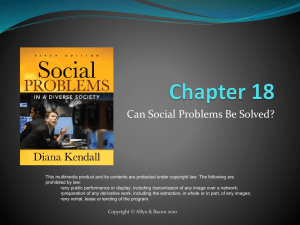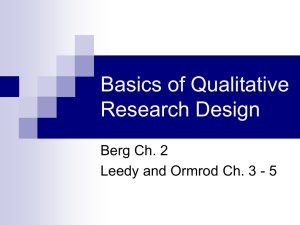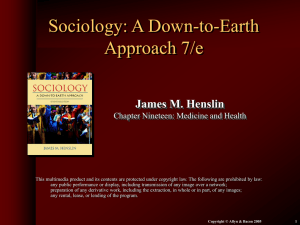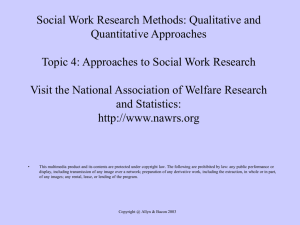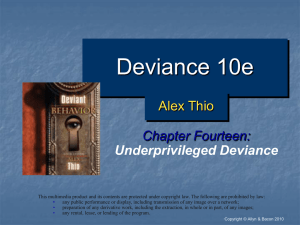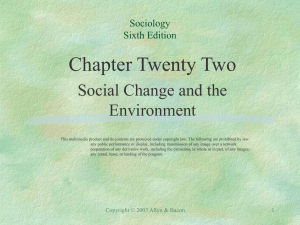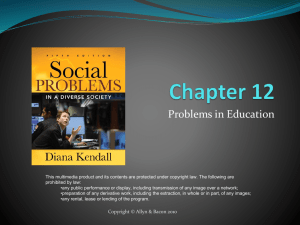Dissociative disorders
advertisement
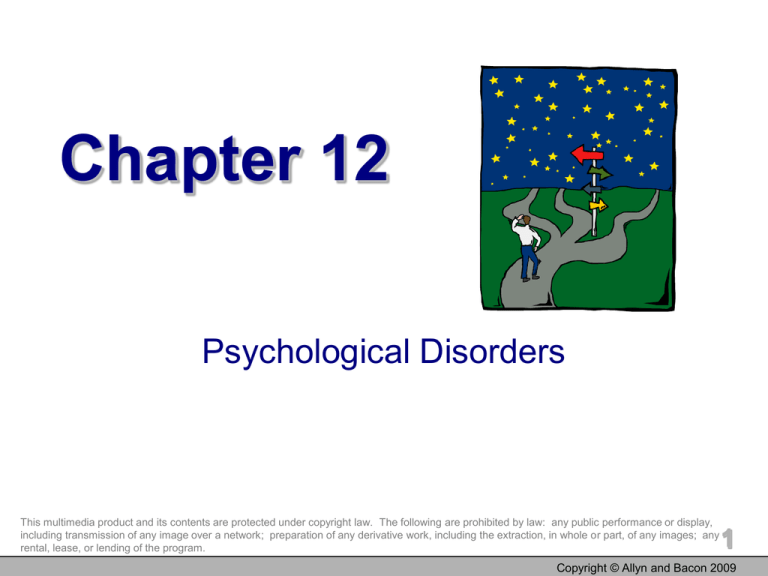
Chapter 12 Psychological Disorders This multimedia product and its contents are protected under copyright law. The following are prohibited by law: any public performance or display, including transmission of any image over a network; preparation of any derivative work, including the extraction, in whole or part, of any images; any rental, lease, or lending of the program. 1 Copyright © Allyn and Bacon 2009 What is Psychological Disorder? The medical model takes a “disease” view, while psychology sees psychological disorder as an interaction of biological, cognitive, social, and behavioral factors 2 Copyright © Allyn and Bacon 2009 What is Psychological Disorder? Three classic signs suggest severe psychological disorder • Hallucinations • Delusions • Severe affective disturbances Part of a continuum ranging from absence of disorder to severe disorder Disorders are a exaggeration of normal responses 3 Copyright © Allyn and Bacon 2009 Changing Concepts of Psychological Disorder : Historical Roots Ancient World • Supernatural powers• Possession by demons and spirits 400 B. C. • Physical causes• Hippocrates-imbalance of humors Middle Ages • Medieval church • Demons and witchcraft 18th Century • Mental disorders are diseases of the mind • Similar to other physical diseases • Objective causes requiring specific treatments 4 Copyright © Allyn and Bacon 2009 Changing Concepts of Psychological Disorder : The Psychological Model Behavioral perspective – Abnormal behaviors can be acquired through behavioral learning – operant and classical conditioning Cognitive perspective – Abnormal behaviors are influenced by mental processes – how people perceive themselves and their relations with others 5 Copyright © Allyn and Bacon 2009 Changing Concepts of Psychological Disorder : The Psychological Model Social-cognitive-behavioral approach • combines psychology’s 3 major perspectives • Behavior, cognition, and social/environmental factors all influence each other • Recognize the influence of biology 6 Copyright © Allyn and Bacon 2009 Indicators of Abnormality Distress Maladaptiveness Irrationality Unpredictability Unconventionality and undesirable behavior 7 Copyright © Allyn and Bacon 2009 Indicators of Abnormality Distress Maladaptiveness Irrationality Does the individual show unusual or prolonged levels of unease or anxiety? Unpredictability Unconventionality and undesirable behavior 8 Copyright © Allyn and Bacon 2009 Indicators of Abnormality Distress Maladaptiveness Irrationality Does the person act in ways that make others fearful or interfere with his or her well-being? Unpredictability Unconventionality and undesirable behavior 9 Copyright © Allyn and Bacon 2009 Indicators of Abnormality Distress Maladaptiveness Irrationality Unpredictability Unconventionality and undesirable behavior Does the person act or talk in ways that are irrational or incomprehensible to others? 10 Copyright © Allyn and Bacon 2009 Indicators of Abnormality Distress Maladaptiveness Irrationality Unpredictability Unconventionality and undesirable behavior Does the individual behave erratically and inconsistently at different times or from one situation to another; experiencing a loss of control? 11 Copyright © Allyn and Bacon 2009 Indicators of Abnormality Distress Maladaptiveness Irrationality Unpredictability Unconventionality and undesirable behavior Does the person behave in ways that are statistically rare and violate social norms? 12 Copyright © Allyn and Bacon 2009 Mood Disorders Major depression • Form of depression that does not alternate with mania • Accounts for majority of mental hospital admissions Seasonal affective disorder (SAD) – Believed to be caused by deprivation of sunlight 13 Copyright © Allyn and Bacon 2009 Mood Disorders Bipolar disorder – Alternating periods of depression and extreme elation Mania – Pathologically excessive elation or manic excitement Depression – Pathological sadness or despair 14 Copyright © Allyn and Bacon 2009 Anxiety Disorders Generalized anxiety disorder – Characterized by persistent and pervasive feelings of anxiety, without any known external cause Panic disorder – Marked by panic attacks that have no connection to events in a person’s present experience Agoraphobia – Fear of public places/open spaces 15 Copyright © Allyn and Bacon 2009 Anxiety Disorders Phobia or phobic disorder – Disorder involving a pathological fear of a specific object or situation Cause: Preparedness hypothesis – Notion that we have an innate tendency to respond quickly and automatically to stimuli that posed a survival threat to our ancestors 16 Copyright © Allyn and Bacon 2009 Anxiety Disorders Obsessive-compulsive disorder – Characterized by patterns of persistent, unwanted thoughts and behaviors • Obsession-thoughts, images, impulses that reoccur • Compulsions-repetitive, purposeful acts Genetic link-tendency to run in families Learning component 17 Copyright © Allyn and Bacon 2009 Somatoform Disorders Psychological problems appearing in the form of bodily symptoms or physical complaints • Psychosomaticmental conditions lead to actual physical disease • Conversion disorder – paralysis, weakness, or loss of sensation, but with no discernable physical cause 18 Copyright © Allyn and Bacon 2009 Somatoform Disorders Hypochondriasis – Somatoform disorder involving excessive concern about health and disease 19 Copyright © Allyn and Bacon 2009 Dissociative Disorders Dissociative disorders – Group of pathologies involving “fragmentation” of the personality Dissociative amnesia Dissociative fugue Depersonalization disorder Dissociative identity disorder 20 Copyright © Allyn and Bacon 2009 Dissociative Disorders Dissociative amnesia Dissociative fugue Depersonalization disorder A psychologically induced loss of memory for personal information Dissociative identity disorder 21 Copyright © Allyn and Bacon 2009 Dissociative Disorders Dissociative amnesia Dissociative fugue Depersonalization disorder Dissociative amnesia with the addition of “flight” from one’s home, family, and job Dissociative identity disorder 22 Copyright © Allyn and Bacon 2009 Dissociative Disorders Dissociative amnesia Dissociative Fugue Depersonalization disorder Dissociative identity disorder Abnormality involving the sensation of mind and body having separated 23 Copyright © Allyn and Bacon 2009 Dissociative Disorders Dissociative amnesia Dissociative Fugue Depersonalization disorder Dissociative identity disorder Condition in which the individual displays multiple identities 24 Copyright © Allyn and Bacon 2009 Schizophrenic Disorders Schizophrenia – • severe psychopathology • personality disintegrates • Cognitive processes distorted • More common in men than women • First appearance typically before age 25 for men; between 25 and 45 for women 25 Copyright © Allyn and Bacon 2009 Major Types of Schizophrenia Disorganized Catatonic Paranoid Undifferentiated Residual Positive Negative 26 Copyright © Allyn and Bacon 2009 Major Types of Schizophrenia Disorganized Catatonic Paranoid Features incoherent speech, hallucinations, delusions, and bizarre behavior Undifferentiated Residual Type 27 Copyright © Allyn and Bacon 2009 Major Types of Schizophrenia Disorganized Catatonic Paranoid Involves remaining motionless or extreme excitement Undifferentiated Residual Type 28 Copyright © Allyn and Bacon 2009 Major Types of Schizophrenia Disorganized Catatonic Paranoid Undifferentiated Residual Type Prominent feature: combination of delusions and hallucinations 29 Copyright © Allyn and Bacon 2009 Major Types of Schizophrenia Disorganized Catatonic Paranoid Undifferentiated Residual Type Persons displaying a combination of symptoms that do not clearly fit in one of the other categories 30 Copyright © Allyn and Bacon 2009 Major Types of Schizophrenia Disorganized Catatonic Paranoid Undifferentiated Residual Type Individuals who have had a past episode of schizophrenia but are 31 free of symptoms Copyright © Allyn and Bacon 2009 Major Types of Schizophrenia Positive Schizophrenia Negative Schizophrenia Any form in which the person displays active symptoms (e.g. delusions, hallucinations) 32 Copyright © Allyn and Bacon 2009 Major Types of Schizophrenia Positive Schizophrenia Negative Schizophrenia Any form distinguished by deficits, such as withdrawal and poverty of thought processes 33 Copyright © Allyn and Bacon 2009 Possible Causes of Schizophrenia Evidence for causes found in a variety of factors including genetics, abnormal brain structure, and biochemistry Diathesis-stress hypothesis – Genetic factors place the individual at risk, but environmental stress factors transform this potential into an actual schizophrenic disorder 34 Copyright © Allyn and Bacon 2009 35 Copyright © Allyn and Bacon 2009 Diagnostic Labels Depersonalization• Results from labeling • Robbing people of their individuality and identity by treating them impersonally • Reinforces disturbed behavior 36 Copyright © Allyn and Bacon 2009 What are the Consequences of Labeling People? Ideally, accurate diagnoses lead to proper treatments, but diagnoses may also become labels that depersonalize individuals and ignore the social and cultural contexts in which their problems arise 37 Copyright © Allyn and Bacon 2009 The Plea of Insanity Insanity – A legal term, not a psychological or psychiatric one, referring to a person who is unable, because of a mental disorder or defect, to confirm his or her behavior to the law 38 Copyright © Allyn and Bacon 2009



